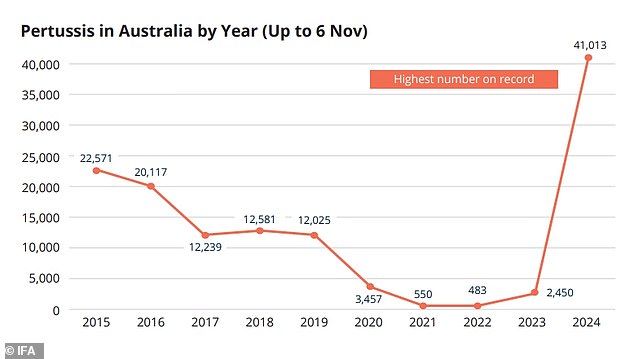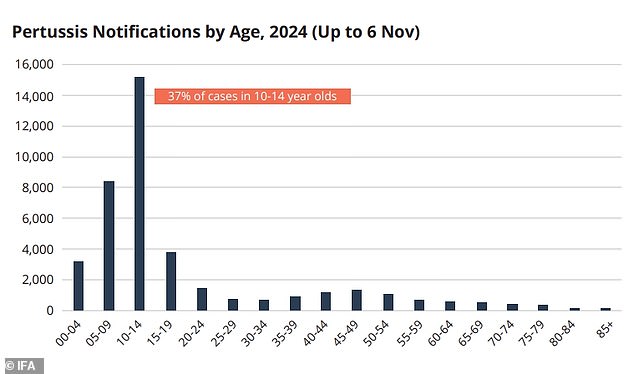Australia battling the largest whooping cough epidemic in over a decade: What you need to know
Australia is battling the largest whooping cough epidemic in history since the invention of vaccines against the deadly disease.
Whooping cough is a highly contagious and potentially fatal lung disease that can be life-threatening for babies and young children.
Health authorities are on high alert after 41,013 cases were recorded this year – more than the previous record of 38,748 cases in 2011.
Up to 130 confirmed cases of whooping cough are recorded every day and up to 45,000 new cases are expected by the end of the year.
Figures show there has been a major spike in cases among school-age children, with almost 40 percent of infections recorded among 10 to 14-year-olds.
Dr. Laurence Luu, Chancellor’s Research Fellow and lecturer at the University of Technology Sydney, said the disease was more contagious than Covid-19.
“Given the significant increase in whooping cough cases, current vaccination rates are a major concern,” he said.
“While we are doing a fantastic job protecting newborns and babies, revaccination or ‘booster’ rates are alarmingly low.”
Whooping cough is a highly contagious and potentially fatal lung disease that can be life-threatening for infants and young children (stock)

Australia is battling the largest whooping cough epidemic in history since the invention of vaccines against the deadly disease (photo, a map of the disease in Australia by year)
The four-week-old son of Immunization Foundation of Australia founder Catherine Hughes AM, Riley, sadly died from whooping cough complications.
She has since urged people to be alert for signs of infection.
“Many people are not aware of the need for a booster vaccine and are likely not adequately protected,” she said.
‘We all have a role to play in controlling the spread of whooping cough and reducing the risk of infection in ourselves and others. Community effort is needed to protect against whooping cough.”
Symptoms of whooping cough do not appear until two weeks after infection, meaning a person can remain contagious for up to three weeks.
The disease can also be treated with antibiotics, with Australians urged to take basic health measures to reduce the spread of the infection.
This also applies to people who cover their nose and mouth when sneezing and coughing and who wash their hands regularly.
By 2023, one in four young Aussies turning 13 would miss their whooping cough booster, while only one in five Australians over the age of 50 are up to date with whooping cough vaccination.
The Immunization Foundation of Australia recommends adults get a booster shot at least every 10 years to maintain protection against the bacterial infection.

There has been a major spike in cases among 10-14 year olds in Australia (pictured)
The disease is highly contagious and is likely to infect the majority of people who come into close contact with a sick person.
Whooping cough usually starts with typical flu-like symptoms such as coughing, runny nose, watery eyes and low-grade fever.
A dry and persistent cough usually lasts for a week and the frequency of coughing produces a ‘whoop’ sound.
Severe cases can lead to pneumonia, bleeding in the nose, eyes or brain, and some children may also suffer brain damage.
